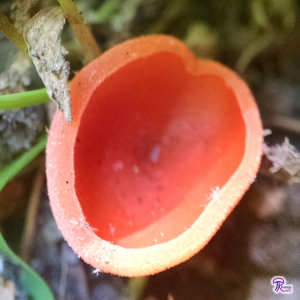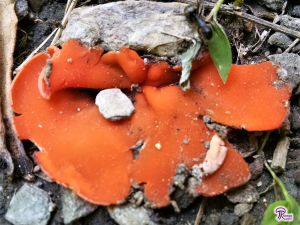#210: Aleuria aurantia, the Orange Peel Fungus

Aleuria aurantia is called the “Orange Peel Fungus” for obvious reasons. The bright orange cup fungi are irregularly lobed and folded so that they look like a discarded orange peel.
Aleuria aurantia has the common name “Orange Peel Fungus” because it looks like a discarded orange peel resting on the forest floor (I love mycology; more often than not, names make sense!). The Orange Peel Fungus is a cup fungus (see FFF#032) but is a bit more saucer-shaped than cup-shaped; it is roughly circular and usually has upturned edges. Often, the mushrooms become lobed and somewhat folded in on themselves. This really makes them look like orange peels, which also become wavy if the pieces are large enough. A. aurantia is small to medium-sized with the largest mushrooms growing about as wide as a small orange.1–3
Description
Cup fungi have only three morphologically distinct areas: the upper (also called “inner”) surface which produces the spores, the lower (or “outer”) surface, and the point of attachment to the substrate. In A. aurantia, the upper surface is smooth and bright orange. The lower surface is paler and covered in whitish fuzz that disappears as the mushroom ages. The mushroom is attached to the ground at a single point at the center of the cup. This point is just a small plug of mycelium and is not organized into a coherent structure.1–3
Overall, the mushrooms are cup-shaped but tend to become saucer-shaped as they get larger. When fully grown, the mushrooms usually reach sizes of 3-7cm across but sometimes grow as wide as 10cm across. Larger mushrooms and those growing in clusters often develop lobes and sometimes fold in on themselves on one side to make ear-like shapes. A. aurantia has thin brittle flesh, so the folds sometimes develop slits that make the mushrooms even more irregular.1–3
Ecology
The Orange Peel Fungus is a saprobic species that inhabits poor soils. You find the mushrooms fruiting from disturbed ground in areas with lots of clay or gravel. This is good for mushroom hunters because it means the fungus regularly appears on trails and dirt roads. A. aurantia fruits from summer through fall in temperate climates (although I once found it in May) and from fall through spring in more moderate areas.1–3 The mushroom appears across the globe and can probably be found on every continent except Antarctica.4

Small specimens of the Orange Peel Fungus can be mistaken for other mushrooms. Thankfully, A. aurantia usually fruits in clusters and produces mushrooms of varying sizes.
Similar Species
Thanks to its size and color, you are unlikely to mistake the Orange Peel Fungus for anything else. There are some other orangish cup fungi, but they tend to be small and not very wavy or lobed. The mushroom most similar to A. aurantia is Sowerbyella rhenana, which is also orange but is smaller and forms a short stipe.1,5 Another orangish mushroom without a stipe is Acervus epispartius, but that mushroom is felty underneath and has a flap of tissue that covers the inside of the cup when young.5 Species in Otidea are similar in shape because they usually have a slit on one side of the fruitbody. However, Otidea produce the slit much more regularly and have much duller colors than A. aurantia.1 Other vaguely similar mushrooms are the Scarlet Cup Fungi (Sarcoscypha spp., FFF#137). Those fungi are bright red, so you can easily distinguish them from the Orange Peel Fungus.3
A. aurantia may actually be a species complex including species that are distinguished only by spore size or DNA.1 If that is the case, expect to see a few more names pop up for regional variants of the Orange Peel Fungus sometime in the future.
Edibility
The Orange Peel Fungus is considered edible. A. aurantia is common enough and grows big enough that you could make a dish with this mushroom. Unfortunately, the fungus is completely uninteresting from a culinary standpoint. You could perhaps use it to add a splash of color to something, but that’s all you’ll get out of this mushroom.2,3
Taxonomy
A. aurantia is an ascomycete that belongs to the order Pezizales.6,7 This order contains most of the cup-like ascos. By “cup-like” I mean mushrooms that have asci spread evenly along an exterior surface (many other ascos produce spores internally and release them through tiny holes). This includes morels, false morels, and similar mushrooms. However, within the Orange Peel Fungus’s family – Pyronemataceae – there are primarily other cup fungi.6
The name Aleuria aurantia roughly translates to “golden flour.” Aleuria (from the ancient Greek for “flour”)8 presumably refers to the white powdery underside of the mushroom while aurantia (meaning “golden”) refers to the mushroom’s bright orange color3.
| Kingdom | Fungi |
| Division (Phylum) | Ascomycota |
| Subdivision (Subphylum) | Pezizomycotina |
| Class | Pezizomycetes |
| Subclass | Pezizomycetidae |
| Order | Pezizales |
| Family | Pyronemataceae |
| Genus | Aleuria |
| Species | Aleuria aurantia (Pers.) Fuckel7 |
This post is not part of a key and therefore does not contain enough information to positively identify any mushroom. When collecting for the table, always use a local field guide to identify your mushrooms down to species. If you need a quality, free field guide to North American mushrooms, I recommend Michael Kuo’s MushroomExpert.com. Remember: when in doubt, throw it out!
See Further:
http://www.mushroomexpert.com/aleuria_aurantia.html
https://www.first-nature.com/fungi/aleuria-aurantia.php
Citations
- Kuo, M. Aleuria aurantia. MushroomExpert.Com (2005). Available at: http://www.mushroomexpert.com/aleuria_aurantia.html. (Accessed: 20th April 2018)
- Wood, M. & Stevens, F. California Fungi—Aleuria aurantia. The Fungi of California Available at: http://www.mykoweb.com/CAF/species/Aleuria_aurantia.html. (Accessed: 20th April 2018)
- O’Reilly, P. Aleuria aurantia (Pers.) Fuckel – Orange Peel Fungus. First Nature Available at: https://www.first-nature.com/fungi/aleuria-aurantia.php. (Accessed: 20th April 2018)
- Orange Peel Fungus (Aleuria aurantia). iNaturalist.org Available at: https://www.inaturalist.org/taxa/48716-Aleuria-aurantia. (Accessed: 20th April 2018)
- Beug, M. W., Bessette, A. & Bessette, A. R. Ascomycete fungi of North America: a mushroom reference guide. (2014).
- Kuo, M. Mushroom taxonomy: The big picture. MushroomExpert.Com (2014). Available at: http://www.mushroomexpert.com/taxonomy.html. (Accessed: 20th April 2018)
- Aleuria aurantia. Mycobank Available at: http://www.mycobank.org/name/Aleuria%20aurantia&Lang=Eng. (Accessed: 20th April 2018)
- Volk, T. J. Aleurodiscus oakesii, the oak parchment, cause of ‘smooth patch disease’. Tom Volk’s Fungi (2006). Available at: http://botit.botany.wisc.edu/toms_fungi/apr2006.html. (Accessed: 20th April 2018)










![#011: Characteristics of Kingdom Fungi [Archived]](https://www.fungusfactfriday.com/wp-content/themes/hueman/assets/front/img/thumb-small-empty.png)
